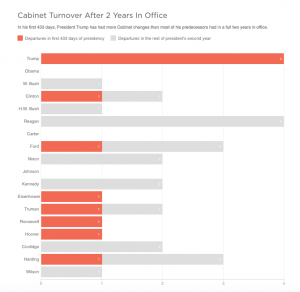The Effect of Cabinet Turnover on Trump’s Presidency
The president’s cabinet is composed of the heads of major executive departments, the Vice President, the Chief of Staff, and many other officials such as the Director of National Intelligence. While never explicitly mentioned in the Constitution, the presidential cabinet can be an aide to the president whenever he or she sees fit. While it is not a decision-making body, the cabinet can help the president make a decision.
President Trump’s Cabinet has been the source of a lot of media attention since he first took office in January 2017. According to NPR, Trump’s Cabinet turnover has set a record – “No elected first-term president in the past 100 years has had this much Cabinet turnover this early in his presidency.” In comparison to past presidents, the rate at which President Trump has dismissed people from his Cabinet is unheard of. This constant change has led the public to believe that the Cabinet, and by extension the Administration, is in a state disarray and turmoil. It also casts doubt on Trump as a leader – if other President’s sustained a stable cabinet, what is so different about Trump? Some people believe it shows his inability to be a leader, or that it’s because he doesn’t get along with anyone who doesn’t agree with him. While this very well may be true, public policy professor James Pfiffner offers up a different approach.
It’s no secret that President Trump is slightly unconventional – a political outsider, he does things different than past Presidents. According to Pfiffner, typically the cabinet is stable for the first two years of a presidency. After the midterm elections turnover begins to happen. He states, “Other presidents wanted to save face for themselves and not look like their Cabinet is in disarray.” This accounts for the typical early stability in presidential cabinets. To take this analysis on step further, Pfiffner also points out the fact that most presidents have a political background and thus choose cabinet members from inside Washington who they have a historical background with. When examining Trump’s cabinet choices, such as Exxon Mobil’s Rex Tillerson for Secretary of State, it is clear that his lack of political background further amplifies his unconventional choices.
Still, as displayed on the graph below, it is shocking to compare the turnover in Trump’s Cabinet versus that of other presidents during the same timeframe. With 32 senior staffers (CNNpolitics) exiting the White House since January 20, 2017, either President Trump is truly failing at convening an appropriate cabinet, or past Presidents were much better at tolerating mistakes among their staff.
I believe that it is difficult to compare President Trump’s time in office to those of past presidents. According to the textbook, the presidency has morphed over time. Newer presidents have taken on roles and exerted power in places where the framers wouldn’t have expected. As technology and society progresses, so too must those who lead us.
Unfortunately, no matter what is causing the turnover in the current cabinet, the connotation is overwhelmingly negative. The cabinet is supposed to consist of advisors who the president trusts. If Trump can’t even trust his own cabinet, then what’s the state of his relationship with those who are outside of his circle of trust and his party? It the Cabinet doesn’t stabilize soon, will this hurt Trump’s chance at reelection? Lastly, is this cabinet turnover totally negative, or is there another perspective that offers a positive view of this situation?
https://www.npr.org/2018/03/19/594164065/trump-cabinet-turnover-sets-record-going-back-100-years
https://www.cnn.com/2018/04/10/politics/donald-trump-tom-bossert/index.html
